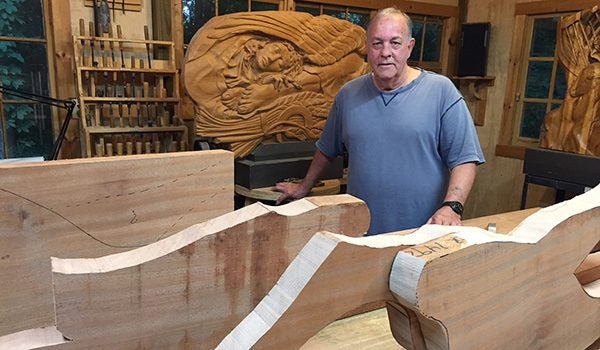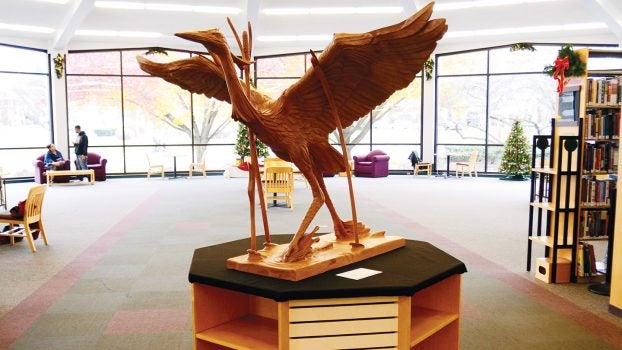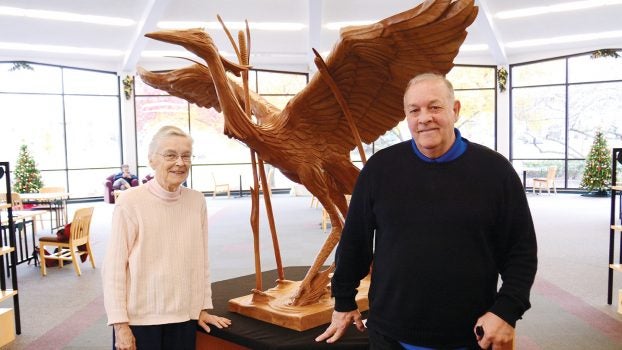Great Blue Heron sculpture gifted to the city
Published 8:30 am Wednesday, December 6, 2017
NILES — Several years ago as Janey Waterhouse was walking her Golden Retriever, Ben, along the trail in Riverfront Park, she looked out across the St. Joseph River and saw a Great Blue Heron. The bird stood on the western bank, wings folded against its body. Waterhouse moved on, but the image stayed with her. It was not much farther down the path that Waterhouse spotted another Great Blue Heron, poised to snatch a fresh fish from the water near the French Paper Mill dam.
“Each of these sightings was special and left a big impression on me,” Waterhouse said.
With the craftsmanship of native Niles artist John Van Dyke, Waterhouse was able to turn the images she saw on the banks of the St. Joseph into a gift of gratitude to the city of Niles. Waterhouse presented Van Dyke’s creation of an approximately 4-foot-tall Great Blue Heron carved from mahogany wood as a gift to the city in November. The sculpture is housed on the Niles District Library rotunda — its six-foot wingspan complemented by a backdrop of autumn leaves visible through the window.
It took Van Dyke about a year and a half to turn three 12-foot beams of wood into the work of art. The sculpture’s details — from the intricately carved feathers to the textured cattails — reveal the care and craftsmanship that went into its creation.
Throughout her more than 60-year residency, Waterhouse said she grew to love the city of Niles and all it offered to her and her family.
“[My family] had all kinds of opportunities for service and fun,” Waterhouse said. “It was time to say thank you. It seemed that the bird and thank you went together.”
The location is only temporary. Waterhouse said the library will house the bird until February 2019, when the city will decide where to move it to next.
The idea to turn her memory of those Great Blue Herons on the bank into a gift to the city could not have been accomplished without Van Dyke, Waterhouse said.
“He picked up the dream,” Waterhouse said.
The two Niles residents ran into each other at a 2013 Niles Art Association program, when Van Dyke was presenting some of his work. Waterhouse said some of Van Dyke’s pieces featured carved wings. She then told Van Dyke about her idea to create a free-standing sculpture featuring the bird that had left an impression on her memory.
Van Dyke’s passion for sculpting is known by the city. He has also crafted a depiction of the Underground Railroad, which Van Dyke gave to the city as a gift and is now among the historic artifacts at the Fort St. Joseph museum.
Van Dyke is a retired art teacher who served school districts across Michiana for more than 25 years, including Galien and Cassopolis. In addition to teaching, sculpting is Van Dyke’s longtime passion.
When Waterhouse brought the project idea to Van Dyke, it brought back his own memories of seeing Great Blue Herons on the St. Joseph River.
In the 1960s, Van Dyke and a group of friends built a raft to navigate the St. Joseph River, when he recalls seeing a bird launch itself from the bank of the river.
“Its odd shape and enormous wing span looked more like a pterodactyl than any bird we had ever seen,” Van Dyke said. “It flew ahead of us, gracefully, its feathers barely clearing the water.”
In his sculpture, Van Dyke tried to capture the magnitude and beauty he saw in the bird. The sculpture’s wing span is only slightly larger than a living Great Blue Heron’s actual wing span, which measures about 72 inches. Van Dyke also had to use some ingenuity to keep the wooden wings aloft. Surrounding the bird’s wings are strategically placed cattails, which help to support the weight of the wings. Waterhouse said this is part of the genius and beauty in Van Dyke’s design of the sculpture.
Van Dyke also utilized a mallet and chisel technique, which helped to craft some of the details that observers can notice when appreciating the art.
“I had never given feathers much thought, or wings for that matter,” Van Dyke said. “It was a new experience.”
Initially, the sculpture was intended to be displayed inside of the Carnegie Building, which currently houses the Four Flags Chamber of Commerce at 321 E. Main St. The city had been talking about putting an art exhibit inside of the building, but plans changed and it was decided that the best place for the bird would be inside of the library’s rotunda.
Waterhouse also hopes to have a plaque eventually placed near the sculpture that reads: “The nest from which we spread our wings.”
Waterhouse said she hopes the sculpture inspires others to give back to the city.








